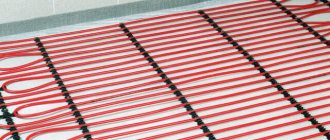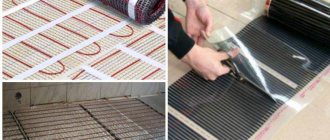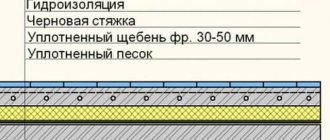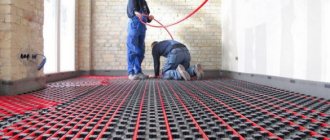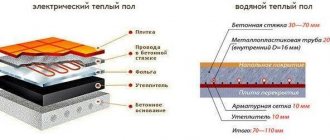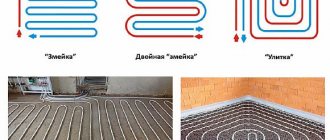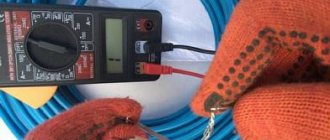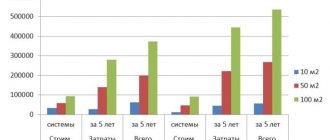Is thermal insulation necessary for underfloor heating or not?
Thermal insulation in the “pie” of a warm water floor plays a huge role; the correct functioning of the entire heating system depends on it. The screed, poured over the thermal insulation, turns into a large surface that transfers heat.
The main functions that a thermal insulation flooring under a warm water floor should perform:
- distribute heat flows evenly throughout the heated room, this is especially important when laying a water structure, since the configuration of this system consists of straight and curved pipes, so the heat is not distributed evenly;
- prevent the outflow of warm air through the ceilings; it serves as a reflective screen, which also makes it possible to save thermal resources;
- act as sound insulation;
- prevent the entry of moisture and cold from below - when arranging a structure above an unheated room or on the ground;
- prevent the formation of moldy and fungal deposits.
In addition, by using polystyrene foam mats with bosses as insulation under a warm water floor, you significantly simplify the process of installing and fixing pipes.
For your information! If the thermal insulation layer is correctly selected and laid, the floor “pie” turns into a closed thermal device, where thermal radiation is distributed evenly and in the desired direction.
Thermopol - the optimal insulation for water heated floors
Another material that I often use as insulation for laying water heated floors. The advantage of such insulation is that the pipes are laid in special grooves. The speed and ease of installation of the insulation itself and pipes is the main advantage of such insulation. Any thickness of the same extruded polystyrene foam can be laid under it. When pouring, pipes located in the grooves are better protected from damage. You can lay boards or plywood and calmly roll a wheelbarrow or walk with buckets without stepping on the pipes of the water-heated floor. There are also specialized mats with the same special grooves, but their prices sometimes exceed all reasonable limits.
Types of insulation for water heated floors
When selecting a material for a thermal insulator for a warm hydrofloor, you should take into account the characteristics and technical indicators of the room, as well as the base on which the substrate will be installed.
For the most part, the thermal insulation material has the same degree of thermal conductivity. But the thickness of the layer is often required even in the same room.
The most common types of thermal insulation used under water-heated floors include: mineral wool, cork, expanded polystyrene, profile mats. This material has different thermal insulation characteristics and properties, and this should be taken into account when choosing and installing the floor.
For your information! When constructing a warm water structure on the ground, it is recommended to use natural raw materials for insulation: sawdust, expanded clay, washed granulated slag, expanded clay sand.
Let's take a closer look at each type of material for thermal insulation of a heating structure.
Cork backing
Cork is an expensive product because it is made from oak bark. Available in rolls or sheets, but there are no differences in technical characteristics. The only difference is the size and thickness.
Cork backing:
- has low thermal conductivity;
- waterproof;
- environmentally friendly;
- hypoallergenic;
- elastic;
- light-resistant;
- fireproof;
- resistant to sudden temperature changes;
- not susceptible to chemical influences.
A product made from cork is an ideal option for a water-heated floor system, and if funds allow, then it is better to choose it. The thickness of this substrate contributes to effective saving of heat resources, which is especially important when installed on the ground.
Cork is not subject to deformation and shrinkage when pouring concrete screeds. It cannot be harmed by insects and rodents, mold and mildew, and is also not terrible.
However, it should be noted that the use of cork as a substrate will affect the height of the ceilings, and additional reflective material will also need to be purchased.
Expanded polystyrene
Expanded polystyrene is the most common type of thermal insulation under water heating floors, and has a fairly affordable price. It provides high-quality protection from water and steam, a high degree of sound insulation, does not deform from exposure to temperature, does not react to chemicals and resists the formation of mold and mildew.
Thermal insulation consists of many bubbles placed in a shell. To add strength to the structure with this substrate, a reinforcing mesh is used. Ease of installation, which even an inexperienced person can handle, also plays an important role in its popularity. In addition, the service life is several decades.
The main disadvantage of polystyrene foam is a fire hazard, so it must be insulated with a foil backing.
Expanded polystyrene comes in several types, which differ in production technology and properties:
- Extruded polystyrene foam is durable and better performs its main function - thermal insulation. It has increased strength, since the particles are tightly bonded to each other. But the vapor permeability indicator is almost zero. Its thickness is at least 3 cm. The slabs are often colored.
- Foamed - also called polystyrene foam. It has a low specific gravity and a high degree of vapor permeability. It is not recommended for foundation insulation, as it is destroyed by moisture. The color is usually white. It is produced in a non-extruded way, that is, the structure has cells with air channels.
- Penoplex - its cost is not high. It has good performance in terms of reflecting heat flows, therefore it is considered one of the best insulation materials. During installation, a waterproofing substrate is not required, and the process itself is not complicated; it is easy to do the installation yourself. Available in slabs of various sizes, the thickness of which ranges from 20 to 100 mm. The package contains from 4 to 20 sheets - it depends on the thickness of the product.
Main advantages:
- high heat and vapor insulation;
- absence of emissions containing harmful substances;
- resistance to the effects of microorganisms;
- does not allow moisture to pass through;
- has high strength.
- Profile mats - they are also based on polystyrene foam. They are stamped using a special technological method and covered with a film for waterproofing. The slabs are high-strength products that can withstand mechanical loads. They are equipped with protrusions; water heated floor pipes are laid in them, which facilitates the process of placing the circuit. They have side locks - this simplifies installation and minimizes the presence of seams. The model is considered the most profitable, in terms of financial investments, when constructing heating.
Mineral wool
Mineral wool is fireproof, unlike polystyrene foam insulation, but its price is more expensive. It is manufactured in slabs, making it easy to install.
When installed on an aluminum underfloor heating base, this insulation has high efficiency, even when placed on the ground. In addition, it has good noise and heat insulation, increased rigidity, and is resistant to chemicals.
The main disadvantage of the product is that it contains carcinogenic and toxic substances that are dangerous to human health. In addition, cotton wool is hygroscopic and vapor-permeable, and when laying it in a screed, care must be taken to protect it from moisture and steam emissions.
Rolled thermal insulation made of foamed polyethylene
Foamed polyethylene (penofol) is gaining popularity today. It is sold in rolls and has a thickness from 3 to 10 mm. The product is equipped with a foil surface, it reflects heat and allows you to significantly reduce the thickness of the “pie”, since there is no need to lay additional waterproofing made of lavsan or thermal insulation.
There are the following types:
- A - one side has a layer of foil;
- B - foil on both sides;
- C (self-adhesive) - there is foil on one side, glue is applied on the other;
- “ALP” - one side is foil, the other with a special film.
Each type is suitable for use under heated floors, and almost completely copes with the thermal insulation of the device.
The technical indicators of foamed polyethylene and polystyrene are largely similar, the thermal conductivity coefficient ranges from 0.037 - 0.049 W/m °C.
It is worth mentioning the ability of the material to absorb water, which results in a decrease in its thermal insulation properties.
In addition, under the influence of a wet screed containing chemicals, the aluminum foil layer becomes unusable. To combat this problem, manufacturers began to produce the product in sheets with a film-like coating on top of the foil.
Metallized lavsan film is capable of qualitatively protecting the screed and flooring from the effects of alkali. Insulation with an aluminum layer without a thermally resistant coating is not used. The positive side of the product is its high degree of heat reflection.
Important! When laying, the foil side of the product should face up.
Penofol, energyflex and the like
Unfortunately, it is one of the most common materials used as insulation for water heated floors. This material is always on display in most heating equipment stores. It is used both by installers and by those who make water-heated floors with their own hands. The opinion is:
♦ firstly, it’s insulation;
♦ secondly, it has reflective foil and directs heat upward;
♦ thirdly, it’s lightweight and fits into any car, even if it can be brought by tram;
♦ fourthly – easy installation, just roll it out and that’s it;
♦ fifthly – very cheap!!!
Let’s say right away that this is the worst insulation option for a water-heated floor. Let's explain why. 1. The foil will effectively reflect heat when there is air in front of it. There is no such air in the screed. Everything is tight. 2. Mortar or concrete eats away at the foil very quickly. Look at the picture. A broken piece of screed on which the foam foil sticks.
The same piece of solution, only three days later:
We think it’s better not to experiment without comments or on yourself. There was no trace left of the foil. Some may say that you can cover it with plastic film, and some manufacturers have already begun to produce such material with a film applied. Yes, in this case the foil will be protected and preserved, but the reflection effect will still not appear. 3. Insulation thickness. Most often, penofol or a similar material is used for laying 3.5 or 10 mm thick water-heated floors under pipes. Is this thickness enough? Let's say right away that you will lose heat into the ground. If you have mains gas, it may not be very noticeable in financial terms, but if you heat with electricity, cylinders or diesel, the amounts here will not be small. We offer several calculations. The thermal conductivity coefficient of penofol ranges from 0.37 to 0.50 W/m*C. Filling with cement-sand mortar.
Calculation with a penofol thickness of 5 mm
More than half of what goes into the room goes into the ground.
Calculation with a thickness of penofol 10 mm
Also big losses. When supplying 45C, 30 watts go to the floor. Let's do the math and draw a conclusion. Every hour it takes 30 watts per m2. 30*24*149=107280 W or 107 kW per heating season. 24 hours in a day 149 – heating period in Krasnodar. In other regions it may be significantly higher. Today, the cost of 1 kW of electricity is about 3.5 rubles. 107 * 3.5 = 374.5 rubles will cost every square meter, every year. This kind of money will be enough for any good insulation and there will even be some left over, and next year there will be complete savings. If, when pouring, instead of cement-sand mortar, you use a semi-dry screed... This will be an even greater loss of heat and your hard-earned money. And less heat will go up. We will get the most incorrect and most wasteful underfloor heating in the world. Conclusion: penofol and similar materials cannot be used as the only insulation for a water heated floor system. If you put extruded polystyrene foam under the penofol, for example, and roll out the penofol with markings on top, for the convenience of installing a heated floor with a certain step, this will be correct.
Which insulation to choose?
As mentioned above, a warm water floor requires insulation, since without it it will not function effectively. In addition, if there is thermal insulation, the system is more economical. It is important not only to know how to properly insulate a heated floor, but also how to choose a suitable heat-reflecting material.
When purchasing thermal insulation, you need to look not only at the characteristics, heat-saving properties of the material and its parameters, but also at its service life. Since a number of products with good performance often have a short service life.
Therefore, there will be a need to replace it before maintenance of the system itself is required. This is especially important in rooms with tile flooring, because it is difficult to dismantle it. In this regard, experts advise purchasing a product with a warranty period of 10 - 15 years.
Among the properties that are recommended to pay attention to:
- level of thermal conductivity;
- resistance to mechanical loads and dynamic influences;
- density indicator;
- hydro and vapor tightness.
For rooms with high ceilings, it is better to choose durable, rigid types that have a polymer base. If you are insulating a room with wooden floors, mineral wool is an excellent option, because it is fireproof.
For your information! You should not save excessively on thermal insulation material when laying a heated floor. Its cost will pay off within 3 years, especially when heating with natural gas.
Installation features
Properly selected material for thermal insulation not only makes staying in the room comfortable, but also reduces electrical energy consumption. The technology for making electric heated floors depends on it.
All work on arranging an electric heated floor comes down to the following operations:
- preparation of the base;
- installation of thermal insulation;
- installation of heating cable/mats/film;
- performing a screed;
- installation of finishing floor covering.
At the base preparation stage, it is necessary to dismantle the old screed, level the surface as much as possible (differences should not exceed 10 mm) and clean it from dirt and dust. If necessary, the base surface must be waterproofed.
Before you begin laying thermal insulation for an electric heated floor, you need to decide on its thickness. It has been experimentally established that above unheated rooms it should be 50÷100 mm, and for interfloor ceilings - 20÷30 mm. Seams and joints of thermal insulation must be taped with special tape (foil), between the wall and the screed - with damper tape. When laying several thermal circuits with different temperatures, a T-shaped damper profile is used to separate them.
Thermal insulation material is not only laid on the base of the floor, it must be laid along the perimeter of the wall to a height of up to 20 mm.
Installation of electric heating elements must be carried out taking into account the characteristics of the installed system (single- or two-core cables, mats, UV films).
It is better to screed the floor using a sand-cement mortar with the addition of special plasticizers that will prevent cracking. Its thickness should be at least 3 cm. After drying, begin laying the finishing floor covering. It can be tiles, parquet, linoleum or another type. They are installed taking into account the manufacturer's recommendations.
teplota.guru
Features of laying insulation
The principle of installing a thermal insulation layer is simple, no special tools or special experience are needed, the main thing is to follow the technological process.
Watch the video on how to choose insulation:
How to choose insulation for a heated floor. Lifehack from Design.rf
Installation of polystyrene foam boards
The work of installing polystyrene foam boards under a heated water floor is as follows:
- Regardless of the type of thermal insulation product, you need to start by preparing the subfloor. It should be smooth, without cracks. If irregularities and flaws are found in the surface, they need to be repaired.
- Waterproofing measures consist of arranging a layer that protects against moisture, this can be a polyethylene film.
- Sticking damper tape around the perimeter of the room is necessary to compensate for temperature fluctuations.
- Laying insulation boards over the entire area - the sheets are fixed to the base using plastic staples or dowels; the product can be installed with glue.
- Spreading foil film and installing reinforcing mesh over the insulation.
- Installation of heating elements (pipes) - they are attached to the grid according to the planned scheme. The seams between the plates should be taped with tape, this will help retain heat.
- Pouring concrete screed over the pipeline. To ensure surface strength, it is recommended to add plasticizers to the solution. It is necessary to let the mixture harden, this will take about a month.
- The last step is the installation of the finishing coating.
For your information! It is worth considering that underfloor heating pipes with the coolant inside have significant weight, plus the screed and finishing coating, all of this together will push through the insulation over time.
To avoid this, high-strength thermal insulation is required. In addition, to strengthen the structure and distribute the load evenly, it is recommended to reinforce or lay polystyrene foam slabs with bosses. In addition, such mats facilitate the process of placing pipes and fixing them.
Laying rolled polyethylene foam
Installation work on the construction of a water-heated floor using rolled polyethylene as insulation begins with leveling and cleaning the base.
At the second stage, the heat-insulating material is prepared. This consists of cutting the heat insulator into strips of the required length using a stationery knife.
Next, the foil product is placed on the prepared base with the metallized surface facing up to ensure the best reflection of heat. The canvas should extend onto the walls, this is necessary to compensate for the expansion of the screed when heated. The insulation is attached to the floor using glue or double-sided tape. And the seams should be taped using single-sided tape.
The process of installing a water circuit on polyethylene rolls is facilitated by the presence of installation markings printed on it, which show the distance between the pipes. Heating elements on penofol can be placed in a “snail” or “snake” pattern.
Further work on the construction of water heated floors consists of installing reinforcing mesh, pouring a concrete screed and laying the floor covering.
For your information! For use in a warm water device, ALP brand penofol is recommended.
Laying mineral wool
Mineral wool cannot be crushed, so the most optimal way to install it is on the floor, with the installation of logs.
Step by step, the installation of the “pie” of a warm system with a thermal insulation substrate made of mineral wool is as follows:
- Preparation of the base is a mandatory stage of work when installing any heated floors. If the floors in the house are old, then it is better to completely remove them down to the concrete floor or rough wooden floor. The surface must be inspected for irregularities and cracks; if any are found, they are repaired.
- Laying a hydro- and vapor barrier substrate is a necessary step when using mineral insulation, as it is resistant to moisture. For these purposes, roll-type waterproofing - roofing felt, or other modern materials - is suitable. The sheets are fixed to the base using polymer or bitumen mastic. The material is laid in an overlap, the seams should be coated with mastic.
- Arrangement of wooden logs - they are attached to the subfloor over the entire area. Blocks measuring 5 by 6 cm are taken and installed on a concrete surface, secured with dowels, and on a wooden floor with self-tapping screws. The pitch between the fasteners depends on the flooring that is planned to be laid; it ranges from 40 to 80 cm. It requires making cuts in the joists to rotate the contour.
Important! If mineral wool is used as insulation, then the distance between the logs should exceed the width of the material by 1.5 - 2 cm.
- Laying insulation - mineral wool is installed in the spaces between the bars. It is necessary that it sinks at least 5 cm, as a ventilation gap is required.
- Installing a second waterproofing layer is necessary, because cotton wool is not moisture resistant. An ordinary polyethylene film is used, which is placed in a stretch on the logs and fixed with a stapler.
- Preparing the substrate for pipes - slats are used that are nailed across the logs, with a distance of 30 cm from the walls. There should be grooves between the slats in which a metal profile for laying pipes will be placed. Their size depends on the step of laying the contour.
For your information! The metal profile can be replaced with foil in which the pipe is wrapped.
- Installation of the heating circuit - heating pipes are laid into the installed profile according to the planned layout.
- Installing interior flooring - this can be chipboard or plywood.
- Finally, the floor covering is laid.
At this point, the warm floor with a thermal insulation backing - mineral wool, is ready for use.
Cost of insulation for water heated floors
It remains to announce the cost of the insulation.
Thermopol - we use products. The cost depends on the density and ranges from 190 to 230 rubles per m2. If the base is not level, you have to use additional fasteners. 20-30 rubles are added for each square meter.
Extruded polystyrene foam - the cost of such material is around 4,500 rubles per cubic meter. The cube contains 33 m2 with an insulation thickness of 30 mm. It turns out that 1 m2 costs 135 rubles. Reinforcing mesh. It is needed not so much for reinforcement as for fastening pipes with a certain laying step, and so that the water-heated floor pipes do not float up when pouring. It is necessary to take with a reserve for overlap. The cost of a 3 mm mesh with a cell of 150*150 mm is around 60 rubles. With the overlap factor it will cost 70 rubles. Fasteners in the form of mushrooms for insulation 20-30 rubles. In this case it is required. Electric clamps. Needed for attaching pipes to reinforcing mesh. This is about 20 rubles. The cost of the entire set is 255 rubles.
Penofol type underlay for heated floors.
The cost of a high-quality substrate, with a thickness of 10 mm, is around 100 rubles per m2. You can go further in two ways. Either use reinforcing mesh or use a 6 mm dowel clamp to secure the electrical cable. In the first case, the cost will be 170 rubles per m2, in the second 110 rubles per m2. But this option does not work as insulation. We wrote about this above. If we take the golden mean. It is best to use a thermofloor option as insulation for a heated floor. We are ready to design and install turnkey water heated floors Social Like
Optimal insulation thickness
It is important to make the right choice not only of the insulation model, but also of its thickness; thermal energy savings depend on this.
For your information! If the thickness of the insulation is small, then most of the heat goes under the floor, its amount is equal to the flow of warm air rising upward.
The thickness of the insulation should be selected depending on climatic conditions. It is clear that in areas with a cold climate, the layer of thermal insulation material should be larger.
The type of room located under the warm water floor also plays an important role. If this is a cold basement, or the structure is laid on the ground, then the insulation layer should be made thicker, 100 - 120 mm. When constructing a heating floor over a heated room, a sufficient thickness of 30 - 50 mm.
Installing a thermal insulation layer under a heated water floor is not a luxury, but a necessity. Incorrectly done insulation will lead to deterioration in the quality of heating and unnecessary costs.
Installation methods for electric heated floors
There are several options for installing electric floors:
- The electric floor is installed in the thickness of the screed, on top of which the floor covering is laid.
- The electric heated floor is mounted on a screed and ceramic tiles are laid on top of it.
- The electric floor is laid directly under the floor covering itself. Such warm floors are called film floors.
In the first option, electric heated floors are most suitable for heating rooms such as the kitchen (we recommend expert advice on which linoleum is best for the kitchen), bathroom, balcony or loggia. This type of heated floors is called “Cable floors”. The whole technology for laying cable heated floors will be as follows: first you need to lay a layer of waterproofing, then a layer of insulation, then lay the cable electric floor and form a screed on top.
If you also have a warm room underneath, then the electric heated floor can be laid directly under the ceramic tiles without laying a layer of insulation. The tiles themselves and the tile adhesive will protect your electric heated floor and its heating elements quite well. However, carefully study the instructions for the heated floor to see if it includes a method for such installation.
If you have a need to put heated floors under laminate or everyone’s favorite linoleum and you don’t want to bother with screeds, then heated floors such as “Film” are suitable for you, or they are called infrared. The technology itself here is more simple: we lay a layer of foil-clad polyethylene, if necessary, a layer of waterproofing and install our infrared heated floor elements on top. The floor covering is laid on top and the floor is ready.
Types of systems and materials used
There are several types of insulation systems, they depend on the raw materials used. Thermal insulation for heated floors is made from natural and synthetic materials.
Main types:
Cork insulation
Use cork oak bark. The purchased insulation is rolled into a roll with dimensions of 10 m * 1 m * 1 - 10 mm. During installation it fits well and does not require gluing. Has excellent qualities. Some types have a rubberized base, which increases waterproofing properties.
During installation, a thermal reflector must be used so that the heat from the system is reflected to the floor surface.
"Penotrem"
This is a modern heat-insulating raw material of synthetic origin. It is made of porous polypropylene and has a cellular structure. Markings make installation easier, but they may not exist. The heat-reflecting layer is made of aluminum foil. Penotherm increases thermal efficiency by up to 70% if installed correctly. Available for sale in lengths of 10 or 30 m, width 1.2 m, thickness varies.
We install an electric heated floor with our own hands
Before laying all the elements, it is necessary to check the resistance of the heated floor, which must coincide with the technical data sheet. The permissible difference is a maximum of 10 percent of the data in the passport. All elements can be mounted with or without attachment to the grid. If you use ties as fasteners, do not tighten them tightly, otherwise when heated they will simply burst due to the expansion of the heating elements.
We simply spread infrared heated floors upward, on top of the insulation. There are also two technologies - fixing elements to the floor using tape or using the special ears provided. We look at the instructions and directions from the manufacturer.
If in those places where the connecting wire passes there are joints of floor slabs, then it is better to lay the wire above them in a corrugated tube about 10 - 20 centimeters. This will reduce all risks of cable breakage due to thermal expansion of the slabs. All places where you will connect heating elements and cables are laid at a distance of about 20 centimeters from the wall and must subsequently be recessed into a layer of screed.
After completing all types of installation work, we begin checking the electric heated floor. You need to turn it on and gradually increase the regulator level to the most powerful indicator and see how your heated floor behaves. If everything is fine, then fill the screed and after it has dried, we re-check and install the floor covering. I think, friends, that electric heated floors are much easier to make yourself than water or hydraulic heated floors.
